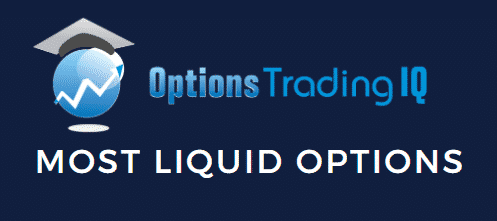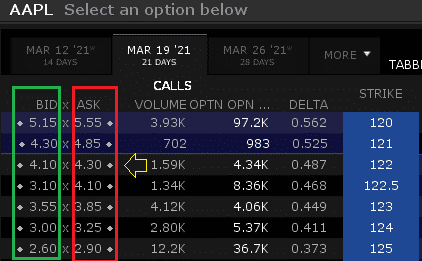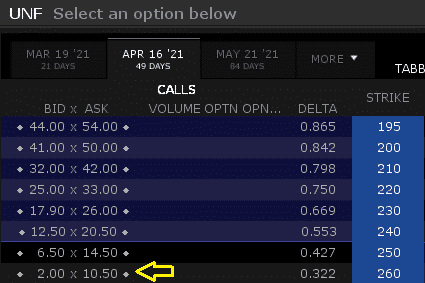

Liquidity is crucial when placing options trades. This article will explore the importance of trading the most liquid options.
I will provide some tips to assure that you are trading the most liquid options.
As lower liquidity equates to higher transaction costs it is important to always be mindful of these costs and how they add up over time.
Contents
- Liquidity Overview
- The Importance of Liquidity When Trading
- Liquidity and Market Depth
- Tips on Finding the Most Liquid Options
- Most Liquid Stock Options
- Most Liquid ETF Options
- FAQ
- Summary
Liquidity Overview
Liquidity in the options space is broadly defined as the price we pay to enter and exit a position.
Even if you are with a commission-free brokerage, trades are not free.
As retail investors, more often than not, we are liquidity takers.
That means we are placing trades interacting with a market maker, who is a liquidity provider.
While there are various ways of measuring liquidity one simple way is the bid/ask spread, as shown below.

The bid price (shown in green) is the highest price someone is willing to pay to buy the option.
The ask price (shown in red) is the lowest price someone is willing to receive to sell that option.
Watch The Bid-Ask Spread
The distance between the bid-ask price is known as the spread.
The larger the spread, the larger transaction costs and thus less liquidity.
Let’s look at the 122 strike shown in yellow.
We have a bid of $4.10 and an ask of $4.30 for a spread of 20 cents.
So, if we were to buy and sell the option immediately the most we would pay is 20 cents. Often the true cost is even less.
This is because there is frequently hidden liquidity within the bid-ask spread.
As we can see with the AAPL options chain the options are very liquid. Below is an example of an illiquid options chain.

Here are the options for Unifirst, a workplace uniform company.
While being a 4 Billion dollar company we can see that there is no volume on the options and virtually no liquidity.
Looking at the bid-ask on the 260 calls we can see the spread is an astonishing $8.50.
These are the options we want to avoid.
If we still want to trade the underlying and have a directional view it would be better off buying the stock.
The Importance of Liquidity When Trading
The most important thing a trader needs to have is a positive expected value on the trades they take.
Without it, we are simply at a roulette table betting on red.
Despite this even if we have a positive expected value without liquidity there is no way to take advantage of it.
After all the less liquidity the more of our edge is eaten up in transaction costs.
Liquidity is always there when you want it but never when you need it.
Sometimes stocks may appear liquid and have tight bid to ask spreads.
Yet during times of market crises that liquidity starts to evaporate.
Markets become fast-moving and the bid-ask spread widens substantially.
More common than not, that is precisely the same time we need the liquidity the most. As others are forced to get out of a position.
By focusing on the most liquid options, we reduce this risk of having our liquidity taken away when we need it the most.
These semi-liquid options can be traded, but need to be handled with care.
Liquidity and Market Depth
Another metric important in determining liquidity is market depth. Imagine that the bid-ask has only one contract on either side but I need to sell 100 contracts.
For most retail traders with smaller investments (myself included), market depth is not a big issue.
But if you start managing millions it becomes a lot more important.
If you listen to a podcast from any fund manager, who has billions of assets under management, they will often spend half the time talking about liquidity.
This is because of the size of their orders and positions.
For them the importance of having market depth and liquidity cannot be overstated.
Tips on Finding the Most Liquid Options
So how does one go about finding the most liquid options? Here are 5 tips that I use.
Focus on tickers that have a high average options volume.
This means, rain or shine, there are a lot of options being traded on the ticker.
I would screen out all the stocks that have under 10,000 daily contracts traded right away.
Look at the option strikes that have a higher open interest.
Certain strikes are more popular, as they are close to the money or are at round numbers.
Think Tesla 990 calls vs. Tesla 1000 calls.
These strikes will often have greater liquidity and a narrower bid-ask spread.

Monthlies have more liquidity than weeklies.
As a general rule if there are weekly contracts available the monthlies will still have more liquidity.
The monthlies are the options expiring on the 3rd Friday of every month.
Consider executing trades around midday.
Options market makers compete against each other to have the bid-ask price as tight as possible.
When the market first opens prices are more volatile and spreads will be wider.
Yet as volatility settles after the open spreads will often tighten as market makers are not as worried about being picked off by price jumps.
Find hidden liquidity for yourself.
Place a limit order slightly below the ask and see if you can find hidden liquidity.
If not move the order down a few pennies or let it rest and see if you get picked off.
Simply by using these five tips you can guarantee that you will be not paying much in transaction costs and make sure you are trading a liquid underlying.
If we are not satisfied with the liquidity of the options we can trade the underlying.
Buying the stock itself will always be more liquid and should be considered if we have a directional view.
Most Liquid Stock Options
Below you will find a list of some of the most liquid options on individual stocks.
This data is from April 2024.
TICKER 90-DAY AVG NOTIONAL
NVDA 2.42b
TSLA 1.9b
META 859m
SMCI 455m
AMD 330m
AAPL 323m
MSTR 296m
MSFT 247m
AVGO 240m
AMZN 214m
COIN 182m
BABA 139m
NFLX 118m
BA 115m
ADBE 88m
GOOGL 86m
LULU 75m
MARA 71m
JPM 64m
PANW 64m
Most Liquid ETF Options
Here is a list of some of the most liquid options on ETF’s.
No major surprises here and this list tends to stay pretty consistent over time.
TICKER 90-DAY AVG NOTIONAL
SPY 1.62b
QQQ 765m
IWM 352m
BITO 58m
TLT 58m
TQQQ 46m
GLD 43m
SMH 41m
SOXL 33m
EEM 33m
EWZ 24m
IEF 24m
HYG 23m
XBI 22m
EFA 20m
GDX 17m
FXI 17m
SLV 17m
DIA 16m
FAQ
What Are The Most Liquid Options?
The most liquid options are those with high trading volumes and tight bid-ask spreads.
This includes options on popular stocks and ETFs, such as Apple, Amazon, and SPY.
Why Is Liquidity Important In Options Trading?
Liquidity is important in options trading because it allows traders to buy and sell options quickly and at fair prices.
Illiquid options can be difficult to trade and may result in wider bid-ask spreads and slippage.
How Can I Find The Most Liquid Options?
You can find the most liquid options by looking at the trading volume and bid-ask spread of each option.
Many online brokers offer tools that allow you to filter options by liquidity.
What Are Some Strategies For Trading Liquid Options?
Strategies for trading liquid options include buying and selling options with tight bid-ask spreads, using limit orders to ensure you get a fair price, and using options with high open interest to ensure that there are other traders willing to take the other side of your trade.
Are There Any Downsides To Trading Liquid Options?
One potential downside to trading liquid options is that the market can be more efficient, making it more difficult to find mispricings and profit opportunities.
Additionally, high trading volumes can lead to higher commissions and fees.
Summary
Liquidity is the cost of doing business in the options space.
When placing trades it is always important to focus on the liquidity of the underlying.
By trading the most liquid options we guarantee we are paying the lowest transaction costs.
Furthermore, we have greater confidence that if we need liquidity, in the event of market turmoil, it will be there for us.
Ultimately this leaves us keeping more of our edge and money in our pockets.
Trade safe!
Disclaimer: The information above is for educational purposes only and should not be treated as investment advice. The strategy presented would not be suitable for investors who are not familiar with exchange traded options. Any readers interested in this strategy should do their own research and seek advice from a licensed financial adviser.











I was looking at CSCO, C, XLF, BAC, EEM, SPY, AAPL, QQQ and saw that the bid/ask spread is less than .15 cents. That seems acceptable, but it’s very difficult to profit if the spread is much more. And the standard expiration options that are near ATM seem to have the tightest spreads. Plus, the open interest is helpful and massive on the major ETFs and Indices: SPY, SPX, RUT, IWM, QQQ, DIA. I really don’t know why there are option spreads which are greater than .20 cents–or rather–why anyone who be enticed by garbage. This game is brutal enough to settle for the worst.